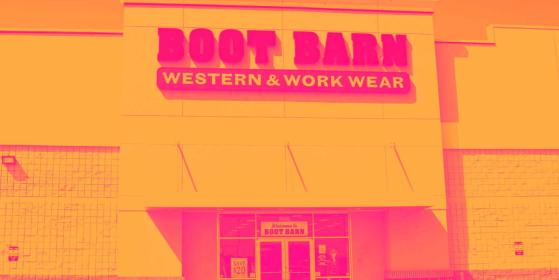Stock Story -
Clothing and footwear retailer Boot Barn (NYSE:BOOT) beat analysts' expectations in Q1 CY2024, with revenue down 8.7% year on year to $388.5 million. The company also expects next quarter's revenue to be around $403 million, coming in 1% above analysts' estimates. It made a GAAP profit of $0.96 per share, down from its profit of $1.53 per share in the same quarter last year.
Is now the time to buy Boot Barn? Find out by reading the original article on StockStory, it's free.
Boot Barn (BOOT) Q1 CY2024 Highlights:
- Revenue: $388.5 million vs analyst estimates of $385 million (small beat)
- EPS: $0.96 vs analyst estimates of $0.89 (8% beat)
- Revenue Guidance for Q2 CY2024 is $403 million at the midpoint, above analyst estimates of $398.8 million
- Management's revenue guidance for the upcoming financial year 2025 is $1.78 billion at the midpoint, missing analyst estimates by 2.5% and implying 7% growth (vs 0.9% in FY2024)
- Gross Margin (GAAP): 35.9%, down from 36.6% in the same quarter last year
- Free Cash Flow was -$31.86 million compared to -$39.64 million in the same quarter last year
- Same-Store Sales were down 5.9% year on year
- Store Locations: 400 at quarter end, increasing by 55 over the last 12 months
- Market Capitalization: $3.24 billion
With a strong store presence in Texas, California, Florida, and Oklahoma, Boot Barn (NYSE:BOOT) is a western-inspired apparel and footwear retailer.
Footwear RetailerFootwear sales–like their apparel counterparts–are driven by seasons, trends, and innovation more so than absolute need and similarly face the bigger-picture secular trend of e-commerce penetration. Footwear plays a part in societal belonging, personal expression, and occasion, and retailers selling shoes recognize this. Therefore, they aim to balance selection, competitive prices, and the latest trends to attract consumers. Unlike their apparel counterparts, footwear retailers most sell popular third-party brands (as opposed to their own exclusive brands), which could mean less exclusivity of product but more nimbleness to pivot to what’s hot.
Sales GrowthBoot Barn is a small retailer, which sometimes brings disadvantages compared to larger competitors that benefit from economies of scale. On the other hand, one advantage is that its growth rates can be higher because it's growing off a small base.
As you can see below, the company's annualized revenue growth rate of 16.5% over the last five years was impressive as it added more brick-and-mortar locations and expanded its reach.
This quarter, Boot Barn reported a rather uninspiring 8.7% year-on-year revenue decline to $388.5 million in revenue, in line with Wall Street's estimates. The company is guiding for revenue to rise 5% year on year to $403 million next quarter, in line with the 4.9% year-on-year increase it recorded in the same quarter last year. Looking ahead, Wall Street expects sales to grow 9.6% over the next 12 months, an acceleration from this quarter.
Same-Store SalesSame-store sales growth is an important metric that tracks demand for a retailer's established brick-and-mortar stores and e-commerce platform.
Boot Barn's demand has been shrinking over the last eight quarters, and on average, its same-store sales have declined by 2.5% year on year. This performance is quite concerning and the company should reconsider its strategy before investing its precious capital into new store buildouts.
In the latest quarter, Boot Barn's same-store sales fell 5.9% year on year. This performance was more or less in line with the same quarter last year.
Key Takeaways from Boot Barn's Q1 Results It was good to see Boot Barn beat analysts' gross margin and EPS expectations this quarter. On the other hand, its full-year revenue guidance missed Wall Street's estimates, sending the stock down 6.5% after hours. Overall, the results could have been better. The company currently trades at $100 per share.
